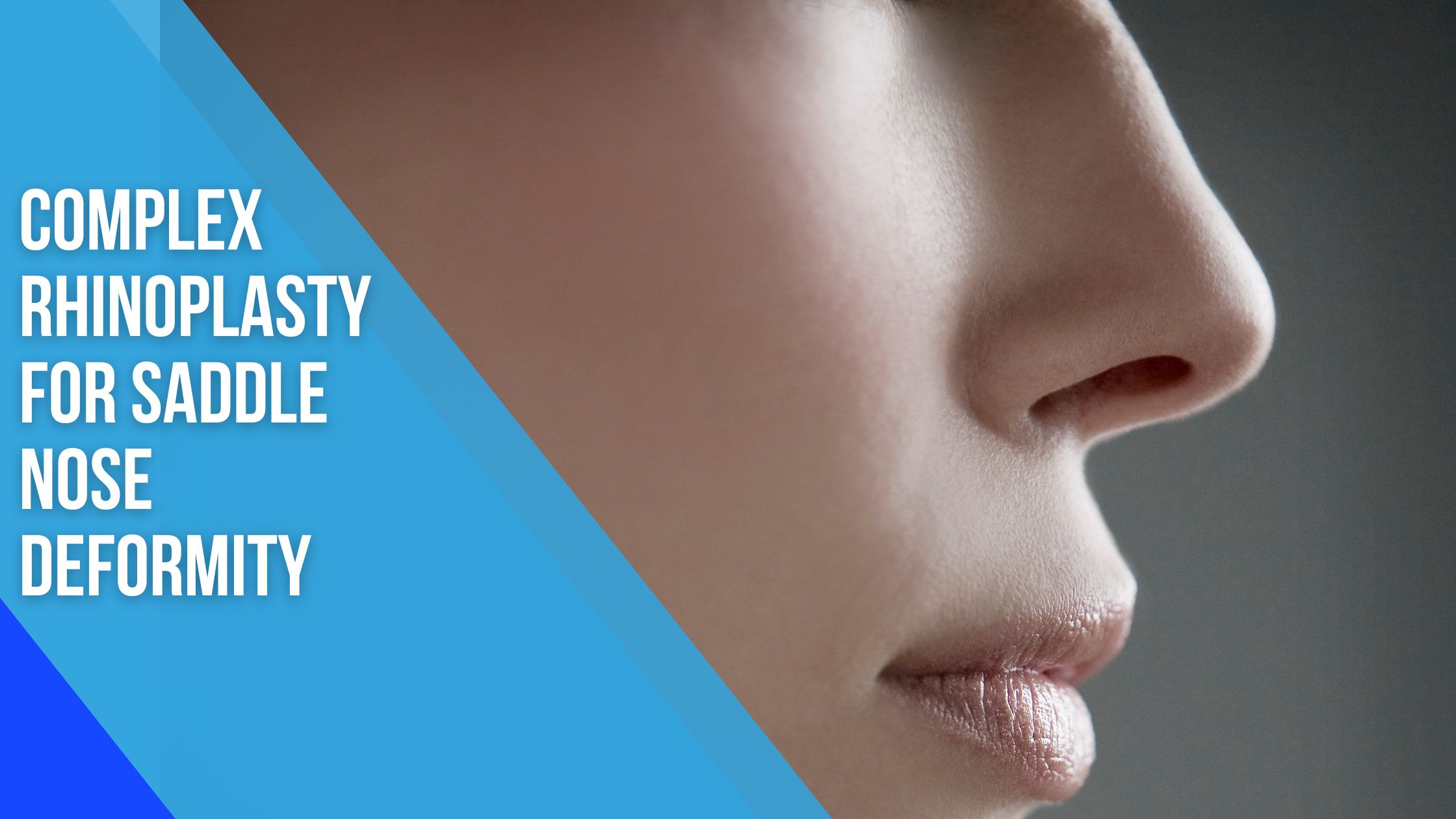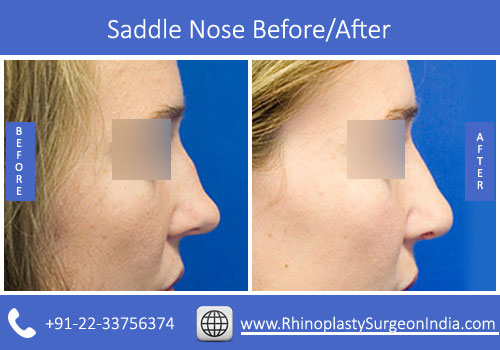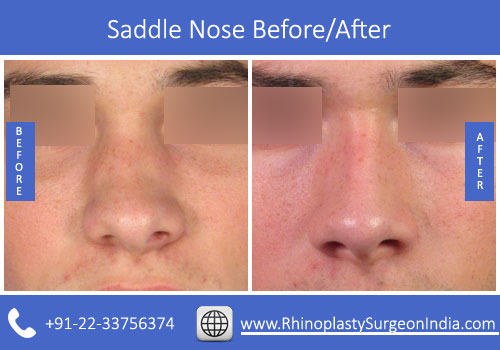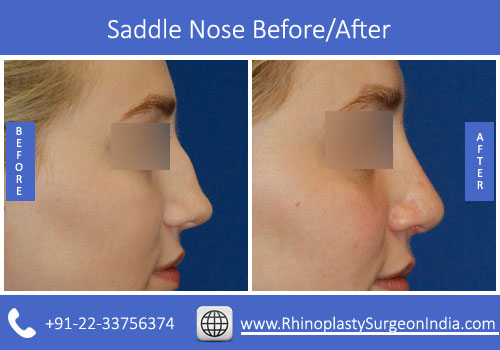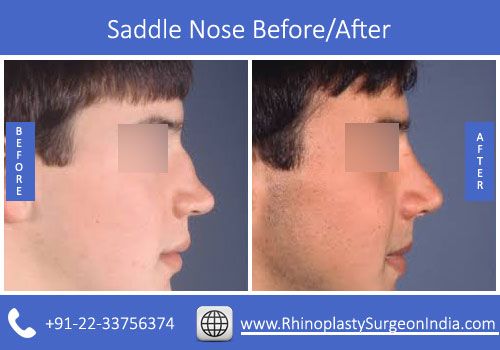Have you ever heard that there is a cradle like dip in the nose? Makes you conscious about the appearance does it not? The nose holds the central position on the face and it plays an important role on how visible or invisible your other facial features are. Crooked nose, with bumpy bridge, a crooked tip etc. all make people often feel dissatisfied with the appearance of their nose may experience self-consciousness or diminished self-esteem. This is why nose-related cosmetic procedures, such as rhinoplasty (nose reshaping surgery), are among the most common cosmetic surgeries worldwide.
Rhinoplasty (simple and complex) can address various concerns, such as altering the size, shape, or position of the nose, refining the nasal tip, or correcting breathing difficulties caused by structural issues including the saddle nose deformity. The goal of a successful rhinoplasty is to achieve a balanced and natural-looking result that enhances the patient’s overall facial appearance while maintaining or improving nasal function.
What is saddle nose deformity?
The bridge of the nose is supposed to be in a straight line from the top to the tip. When some deformity or causes cause the bridge to collapse then it gives the it a sag. The sagging middle portion of the bridge has a concave shape and it is known as the saddle nose. the loss of nasal height gives the nose a sunken appearance. And it is not just about the appearance, the sunken nasal bridge can also cause some breathing issues which can only worsen with time. Saddle nose deformity is also known as pub nose or boxer’s nose. Saddle nose deformity affects the following facial features:
- Nasal Bridge: The most apparent effect of a saddle nose deformity is on the nasal bridge itself. The midportion of the bridge appears sunken or depressed, creating a saddle-like appearance, which gives the deformity its name.
- Nasal Profile: The overall profile of the nose is affected by the saddle nose deformity. Instead of a smooth, gently curved line from the nasal radix (the starting point of the nose) to the nasal tip, the profile may exhibit a dip or depression in the midsection.
- Nasal Tip: Depending on the severity of the deformity, the nasal tip may appear more prominent or drooping in relation to the sunken nasal bridge.
- Facial Symmetry: Saddle nose deformity can disrupt facial symmetry, as the concave nasal bridge creates an imbalance in the central portion of the face.
- Eye-Nose Proportions: A saddle nose deformity can draw attention away from the eyes, potentially making them appear more prominent in comparison.
- Upper Lip Appearance: In some cases, the upper lip may appear more prominent or protruded due to the altered position of the nasal bridge.
- General Facial Proportions: A saddle nose deformity may impact overall facial harmony, especially in profile view, where the nose plays a significant role in determining the facial balance.
It’s essential to consult with a qualified and experienced plastic surgeon or rhinoplasty surgeon or otolaryngologist (ENT specialist) to discuss treatment options and whether surgical intervention is suitable for addressing the saddle nose deformity and achieving desired facial aesthetics.
What causes saddle nose deformity?
Saddle nose or the pug nose can be because of many things. Many causes can cause the septum to collapse and hance the concave appearance. Since the septum is the key ingredient to the structural integrity of the nose, it is also the central pillar of the nose. if something compromises the septum then the nasal structure can collapse. The common saddle nose deformity causes are
- Prior nasal surgery or a nose job: if the patient has had pervious septoplasty or a Septorhinoplasty then it increases the chances of saddling in the future. This happens in cases when the rhinoplasty has been too excessive removing a major part of the septum for severe deviated septum correction. This leads to weaking of what is left of it and eventual collapse. Another reason is when the septoplasty is too young, then as the patient gets older saddling can increase.
- Trauma to the nose: A damage or fracture to the nose can affect the septum. This injury can be because of accidents or contact sports or falls etc. This can lead to nasal saddling or sagging of the nose. Trauma is one of the main saddle nose deformity causes.
- Septal hematoma and septal abscess: This condition leads to collection of blood or pus in the septum because of injury or surgery. this can block or hamper the blood flow in the septum and cause it to collapse and give the nose a concave appearance.
- Vascular and autoimmune disorders: The diseases lead to inflammation or swelling in the nose. This condition is called vasculitis and it decreases blood flow in the septum. When not treated it can cause tissue necrosis and loss causing collapse of septum and loss in the bridge height.
- Substance abuse: Also known as the substance use disorder, snorting drugs like cocaine, methamphetamines, crushed opioid pills or such drugs also lead to damage to septum and loss of blood flow to it leading to saddle nose deformity.
- Infections: infections especially bacterial infections such as syphilis and leprosy damage the bones and cartilage inside the nose. As a result, the septum is not able to get the required blood flow and it weakens. Leading to saddle nose. Saddle nose because of syphilis can be congenital or an acquired symptom.
How do I know if I have saddle nose deformity?
The visible symptom is the external deformity on the nose with the sunken appearance. Another one is a permanent horizontal crease in the lower part of the nose. In most of the cases the location of the deformity indicates poor healing because of injury or damage to the septum. Apart from the concavity of the nasal bridge saddle nose ca also cause difficulty in breathing from our or both nostrils, septal perforation, chronic rusting, nose bleeds and chronic nasal discomfort.
What happens when I don’t get the saddle nose treated?
In mild cases the saddle nose correction using rhinoplasty is mainly done for cosmetic reasons. But in severe cases saddle nose can lead to severe breathing issues along with chronic sinus issues, snoring, obstructive sleep apnea and whistling sounds when you breath through your nose.
How is saddle nose deformity corrected?
There are two approaches to correct sadden nose or the nasal bridge concavity. One is the surgical approach known as open rhinoplasty and the other is liquid rhinoplasty using fillers.
Let’s take a look at them one by one
Rhinoplasty for Saddle Nose Surgery
Here are some common techniques used to correct a saddle nose deformity using rhinoplasty:
- Septal Cartilage Grafting: When the saddle nose deformity is caused by the loss of cartilage and support in the nasal bridge area the septal cartilage grafting is used. During the procedure, the surgeon may harvest cartilage from the nasal septum (septal cartilage) or, if necessary, from the ear or rib, and use it as a graft to rebuild and raise the depressed nasal bridge.
- Diced Cartilage Grafting: In certain instances, diced cartilage wrapped in fascia or other soft tissues may be used as a graft to rebuild the nasal bridge. This technique allows for more precise shaping and sculpting of the bridge.
- Spreaders Graft: A spreaders graft is a type of cartilage graft placed between the upper lateral cartilages, which are the cartilages that make up the sides of the middle part of the nose. This graft helps to widen the middle vault of the nose and improve the nasal shape.
- Dorsal Implants: In cases where there is a significant loss of bone or cartilage in the nasal bridge, synthetic implants or grafts made from materials like silicone, Medpor, or Gore-Tex may be used to augment and support the nasal bridge.
Some other procedures that are often done to restore to its idea and desired nose shape are:
- Nasal Osteotomies: In some situations, the surgeon may perform controlled fractures of the nasal bones called osteotomies to reposition and realign the nasal bones, improving the overall appearance and symmetry of the nose.
- Nasal Tip Reconstruction: If the saddle nose deformity affects the nasal tip, additional techniques may be employed to reshape and reposition the nasal tip, achieving better balance with the rest of the nose.
- Supporting Sutures: The surgeon may use internal sutures to stabilize and support the nasal structures, maintaining the desired correction during the healing process.
Each case is unique, and the specific surgical approach will be tailored to the individual’s needs and anatomy.
Non-surgical saddle nose deformity correction
Also known as liquid rhinoplasty, this type of saddle nose correction is done with the help of dermal fillers. Fillers can only work in cosmetic corrections and do not help with the breathing issues caused because of saddle nose deformity.
Fillers are injection in the skin on the bridge of the nose and they help fill up the concave dip. However, fillers are temporary and they last for only about six months to a year. Fillers can also not be used if the septum damage is too much.
How long does it take to heal after saddle nose deformity rhinoplasty?
Post rhinoplasty it will take about 1-2 weeks for the swelling to start going down. In the meantime, try to avoid any activities than can impact the nose such as running, jumping , rubbing the nose or any other activity that can hurt the nose in any way. In four to six weeks after the surgery you will start seeing changes in the nose and they will continue to improve over the course of the year.
Dermal filler rhinoplasty does not have any downtime and the patient can go about their daily routine without disruptions.
Are there different types of saddle noses?
Yes, depending on the amount of deformity and the lost structural support the saddle noses are classified as follows
- Minimal saddle nose which is just a small depression on the bridge of the nose.
- Moderate saddle nose is a large depression on the dorsum and the nose looks flattened. This might also cause the tip of the nose to turn upwards.
- Major saddle nose in which is very visible concavity combined with lack of bone and cartilage support. The tip of the nose upturns and dorsum sinks in.
How can I prevent or lower the risk of saddle nose?
To stop the saddle nose from getting worse (if it is already present) or to reduce the risk of saddle nose deformity take care of the following
- Treat the fractures or injuries to the nose as soon as possible and with the best rhinoplasty surgeon.
- Reduce the risks of syphilis and syphilitic saddle nose by practicing safe sex practices.
- Wear a nose guard to protect the nasal structure when playing contact sports.
- Avoid substance abuse at all costs
- If you have any autoimmune disease then get them treated correctly.
Saddle nose deformity needs prompt treatment therefore if you notice sagging on the nose bridge the visit a rhinoplasty surgeon immediately.
Saddle Nose Before After Photos, See the Patient Results-
Frequently Asked Questions for Saddle Nose –
Question 1: What causes a Saddle Nose?
Saddle-nose deformity has also been well documented in the context of infections like leprosy and syphilis. It can result from trauma to the nose.
Question 2: What are the stages of Saddle Nose?
The authors first identify the three stages of saddle nose: minimal, moderate, and major, before outlining the treatment strategy used for each stage.
Question 3: Can you fix saddle nose without surgery?
Simple saddle nose deformities, which manifest as a low nasal dorsum, are frequently the result of weakened structural support following trauma or surgery. Using cartilaginous dorsal onlay grafts taken from the nasal septum, adequate augmentation is possible.
Reference Link-
Ref 1:- https://my.clevelandclinic.org/health/diseases/24978-saddle-nose
Ref 2:- https://nycfacedoc.com/conditions/saddle-nose-deformity/
